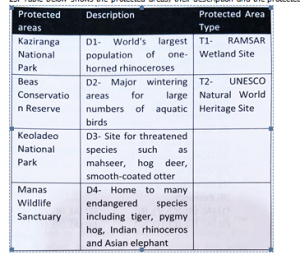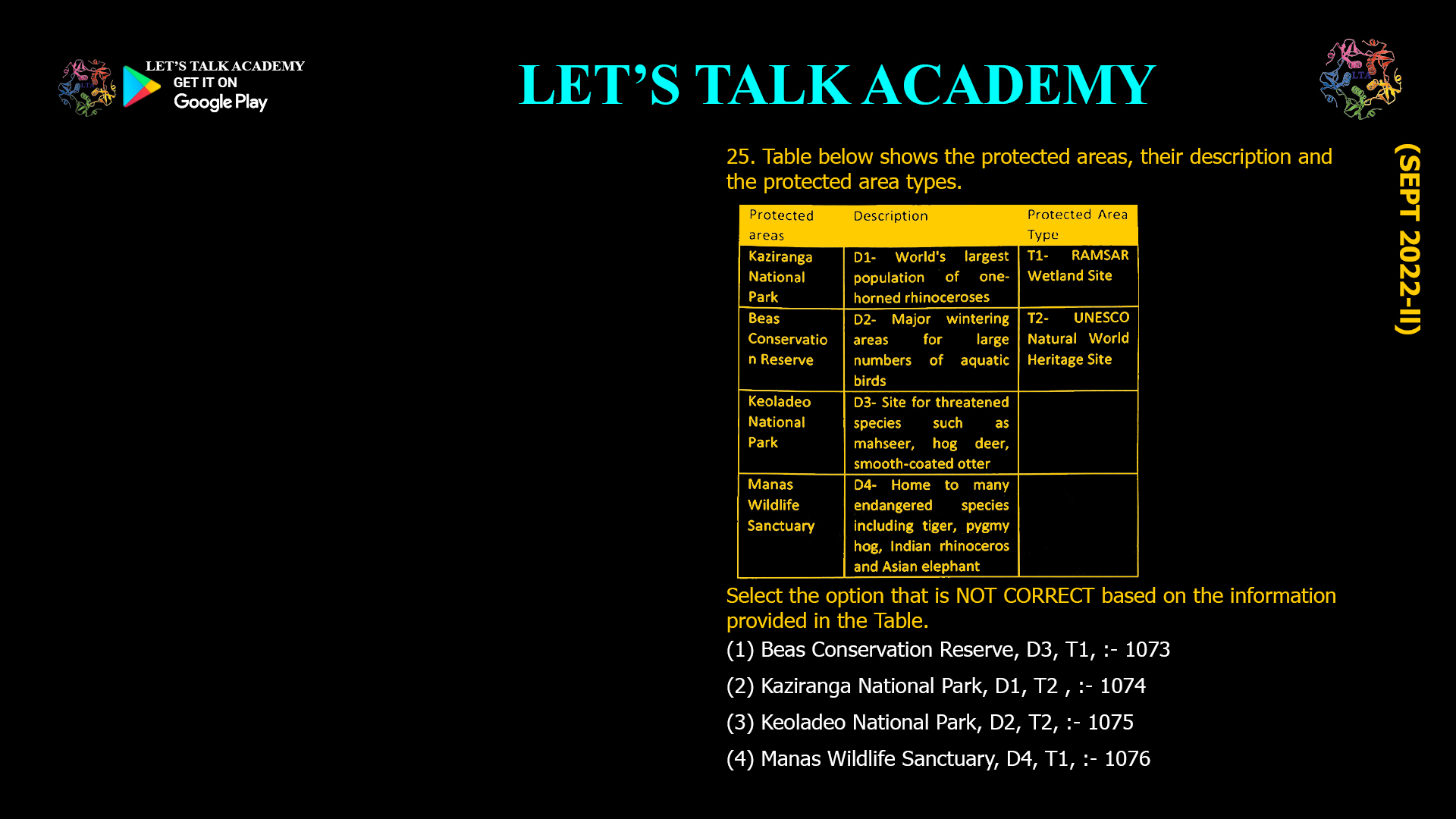- Table below shows the protected areas, their description and the protected area types.

Select the option that is NOT CORRECT based on the information provided in the Table.
(1) Beas Conservation Reserve, D3, T1, :- 1073
(2) Kaziranga National Park, D1, T2 , :- 1074
(3) Keoladeo National Park, D2, T2, :- 1075
(4) Manas Wildlife Sanctuary, D4, T1, :- 1076Identifying the Incorrect Protected Area Description: A Closer Look
Slug: incorrect-protected-area-description-india
Meta Description: Find out which protected area and its description are incorrectly matched based on official Indian conservation records. Learn about the unique features of these key wildlife sites.India’s network of protected areas is vital for conserving biodiversity and safeguarding the habitats of countless species. Each protected area—whether a national park, wildlife sanctuary, or conservation reserve—has a unique designation, description, and type. Understanding these classifications is essential for students, conservationists, and anyone interested in India’s natural heritage.
Let’s analyze the options provided to identify which one is NOT correctly matched based on standard protected area records and descriptions.
The Options
-
Beas Conservation Reserve, D3, T1, :- 1073
-
Kaziranga National Park, D1, T2, :- 1074
-
Keoladeo National Park, D2, T2, :- 1075
-
Manas Wildlife Sanctuary, D4, T1, :- 1076
Understanding the Codes
-
Protected Area Name: The official name of the reserve, park, or sanctuary.
-
D (Description): Usually refers to the specific ecological or administrative description.
-
T (Type): The classification, such as National Park (T2), Wildlife Sanctuary (T1), or Conservation Reserve (T1).
-
Number: Often a reference or serial number in official records or UNESCO World Heritage listings.
Analysis of Each Option
1. Beas Conservation Reserve, D3, T1, :- 1073
-
Beas Conservation Reserve is a designated Conservation Reserve in Punjab, India.
-
Type T1 typically refers to Wildlife Sanctuary or Conservation Reserve, which matches.
-
Number 1073 does NOT correspond to Beas Conservation Reserve in the UNESCO World Heritage Site list or the main protected area numbering.
2. Kaziranga National Park, D1, T2, :- 1074
-
Kaziranga National Park is a UNESCO World Heritage Site.
-
Type T2 is appropriate for a National Park.
-
Number 1074 matches Kaziranga’s official UNESCO World Heritage Site number.
3. Keoladeo National Park, D2, T2, :- 1075
-
Keoladeo National Park (formerly Bharatpur Bird Sanctuary) is a UNESCO World Heritage Site.
-
Type T2 is correct for a National Park.
-
Number 1075 matches its UNESCO listing.
4. Manas Wildlife Sanctuary, D4, T1, :- 1076
-
Manas Wildlife Sanctuary is a UNESCO World Heritage Site.
-
Type T1 is correct for a Wildlife Sanctuary.
-
Number 1076 matches its UNESCO listing.
Conclusion: The Incorrect Match
The Beas Conservation Reserve is NOT correctly matched with the UNESCO World Heritage Site number 1073. In fact, Beas Conservation Reserve is not a UNESCO World Heritage Site, and the number 1073 belongs to a different site. The other three options correctly match the protected area names, types, and UNESCO numbers.
Correct answer:
(1) Beas Conservation Reserve, D3, T1, :- 1073 -



